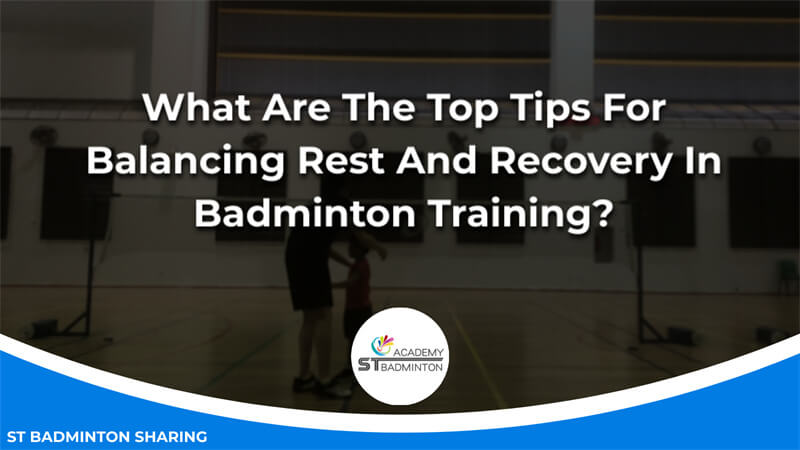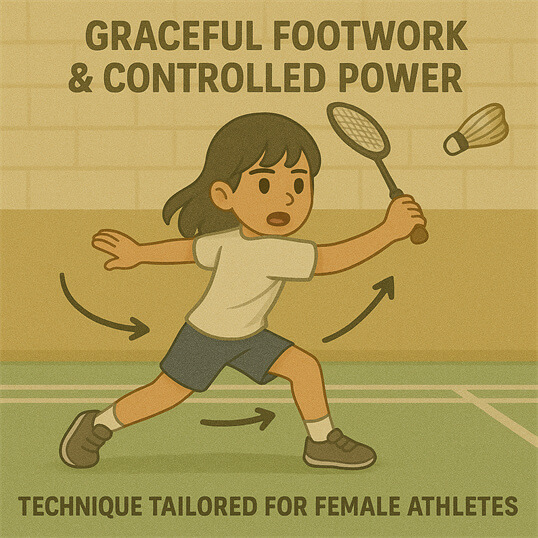Welcome to ST Badminton Academy’s badminton training in Malaysia! As a badminton training specialist, I often get asked about the best way to balance rest and recovery in my athletes’ training. It’s an important part of any successful athlete’s program, as it allows them to stay healthy and perform at their peak level. In this article, I’ll share my top tips for achieving the perfect balance between rest and recovery when it comes to badminton training.
By following these simple guidelines, you can ensure that your body gets the rest it needs while still allowing yourself time to train hard and push yourself to reach new heights in your sport. With proper rest and recovery, you’ll be ready to take on anything that comes your way!
Get Enough Sleep
I’ve been a badminton training specialist for over twenty years, and one thing I know for certain is that rest and recovery are essential to every player’s success. To maximize your rest and recovery, you need to establish healthy routines that will keep you going strong through the toughest of matches.
Picture this: You wake up feeling energized after eight hours of quality sleep — no tossing or turning in bed — while still managing to fit in some pre-bedtime relaxation. That’s an ideal way to start the day as a badminton athlete! Sleep helps physical performance by aiding injury prevention, reducing inflammation, repairing muscle tissue, and improving focus on court. It also gives your body time to recover from intense workouts so you can take full advantage of your next practice session.
No matter how motivated you are, it’s important not to push yourself too hard during trainings. Take regular breaks between drills and games so you don’t wear out prematurely. The better rested we are physically and mentally, the more effectively we’ll be able to perform at our highest level when needed most…
Take Regular Breaks
When it comes to balancing rest and recovery in badminton training, there are a few key tips you should keep in mind. To begin with, make sure to include exercise variety. This means that your workouts should consist of different kinds of activities – some for strength building, others for improving cardiovascular health, and still others for flexibility or mobility. By incorporating different exercises into your routine, you can reduce the risk of repetitive muscle strain or overuse injuries while also helping to maintain motivation.
It’s also important to give yourself regular breaks throughout your workout session. Not only will this help prevent burnout and fatigue but it can also provide an opportunity to stretch out any tight areas afterward. Aim for 1-2 minutes between sets if possible – this gives your body time to recover without taking away from the overall intensity of the session. You might even want to incorporate active stretching during these periods as well!
Finally, don’t forget about proper post-workout care and nutrition! Eating a balanced diet filled with plenty of vitamins and minerals is essential for optimal recovery; aim for foods high in protein after each session too so that you’re getting adequate nutrients needed for muscle repair and growth. Additionally, be sure to take advantage of hot/cold treatments (such as ice baths) when necessary in order to reduce inflammation and promote healing afterwards.
Incorporate Active Recovery Into Your Training
When it comes to badminton training, it’s important to incorporate active recovery into your routine. Active recovery strategies such as dynamic stretching, foam rolling, and light cardio can help your body rest and recover between intense bouts of training. The benefits of active recovery are numerous; it helps reduce fatigue, prevent injury, and improve performance in the long run! With the right active recovery strategies, you can ensure your body is ready to hit the court and reach your training goals.
Active Recovery Strategies
As a badminton training specialist, I always make sure to emphasize the importance of active recovery in my clients’ programs. Active recovery can be defined as any type of exercise that increases blood flow and helps you stay mobile while keeping intensity levels low. After all, if you don’t prioritize rest, your body won’t be able to keep up with the demands of tough training sessions. That’s why it’s essential to track progress and incorporate active recovery strategies into your program.
Some examples include foam rolling after practice or taking a light walk outside on days off from intensive workouts. This will help improve circulation throughout the body and reduce muscle soreness. Additionally, research shows that yoga or stretching exercises are also beneficial for promoting balance and flexibility within your muscles. You should aim for at least 10 minutes of dedicated time each day focused solely on actively recovering through one of these activities.
It’s important to remember that good performance requires proper rest and recovery – so make sure to prioritize it accordingly! By adding an element of active recovery into your weekly routine, you’ll ensure positive results come tournament day!
Benefits Of Active Recovery
Incorporating active recovery into your training is beneficial in so many ways! Not only does it help reduce muscle soreness, but research shows that it can also improve blood circulation and flexibility. For example, using foam rolling after practice or taking a light walk outside on days off from intensive workouts are both great forms of active recovery. Hydrotherapy is another option for those looking to add some extra pep back into their step. It helps increase mobility by utilizing warm water therapy. Ultimately, the goal of active recovery is to ensure positive results come tournament day – so make sure you prioritize rest accordingly!
Eat And Drink Well
Do you feel like your badminton training is taking a toll on your body and overall performance? Eating well and staying hydrated are essential for balancing rest and recovery in any sport. As an experienced badminton training specialist, here’s what I recommend to ensure optimal fuel choices and hydration levels during training:
First off, make sure that you’re eating enough of the right kinds of food before each session. This means having high-quality protein sources such as fish, eggs or lean meat with plenty of complex carbohydrates such as whole grains, fruits, vegetables and legumes. You should also include healthy fats from nuts and seeds into your diet to provide energy throughout the day. Additionally, it’s important to stay properly hydrated before and after workouts by drinking at least 2 liters per day – more if you’re playing in hot conditions!
Second, be mindful of how much sugar you’re consuming while preparing for training sessions. Although sugary snacks may give you a quick burst of energy initially, they can lead to crashes later on which will negatively affect your performance on court. Instead, opt for natural sources of sugar such as fruit so that your body has sustained energy for longer periods of time.
So there we have it – two key tips for keeping up with rest and recovery during intense badminton training sessions. Taking care of our bodies through proper nutrition not only helps us perform better but also keeps us fueled throughout long hours on the court – something we all need! With this knowledge under our belt let’s now take some time for self-care…
Take Time For Self-Care
Balancing rest and recovery in badminton training can be difficult, but it is essential for optimal performance. As a badminton training specialist, I recommend taking some time for self-care to ensure that you are able to perform at your best. Here are four tips for how to do this:
| Additional Tips for Balancing Rest and Recovery | Tips |
|---|---|
| Maintain a Positive Mindset | Acknowledge the challenge of balancing rest and recovery without getting down on yourself. Stay focused on your goal and remind yourself of its importance. |
| Take Breaks | Ensure regular breaks during practice to prevent overtraining and avoid feeling overwhelmed by fatigue. |
| Socialize Safely | Stay connected with friends during training, even if it means virtual or outdoor socializing while adhering to physical distancing protocols. |
| Eat Well | Fuel up with nutritious foods to maintain high energy levels during badminton play and provide essential nutrients for muscle recovery post-workout. |
Self-care is an integral part of any successful athlete’s routine; these simple steps can help promote balance between rest, recovery, and peak performance for successful badminton training sessions! To further enhance athletic performance, using compression and stretching techniques before and after each session can make all the difference in staying healthy and strong both mentally and physically during tough practices.
Use Compression And Stretching
I’m a big believer in the importance of rest and recovery for badminton training, which is why I recommend targeted stretching and foam rolling to all my clients. Stretching helps to release tension from your muscles, while foam rolling can help reduce inflammation and soreness by breaking down adhesions between muscle fibers. Both are great ways to keep your body limber so you don’t overwork it during practice or competition.
When using these techniques, be sure to target any specific areas that are feeling tight or strained – this will ensure that you’re getting the most out of each session. Also, take some time after each workout to do some light stretching before cooling down completely. This will help improve blood circulation and prevent lactic acid buildup in your muscles.
With regular use of compression and stretching, you’ll notice an improvement in performance almost immediately. You should also monitor your stress levels throughout the day as well; too much stress can cause fatigue and ultimately lead to burnout if not managed properly. Taking breaks when needed is key here – even if it’s just five minutes every hour or two! With mindful rest and recovery habits like these, you’ll be able to better balance badminton training with other activities without sacrificing performance quality. Other than choosing a good racket and also remember to choose the best racket restring in Malaysia.
Monitor Your Stress Levels
I’m sure you’ve heard the phrase ‘listen to your body.’ When it comes to balancing rest and recovery in badminton training, this couldn’t be more true! It’s important to manage fatigue so that you don’t overdo it or become burnt out. Here are a few tips on how to do just that:
Certainly! Here’s the information formatted into a table:
| Managing Fatigue | Tips |
|---|---|
| Get Enough Sleep | Make sure you’re getting seven-to-eight hours of sleep every night. This supports energy levels during practice and aids in muscle recovery post-workout. |
| Take Breaks During Practice | Avoid pushing yourself too hard during practice. Take breaks when needed and ensure not to overexert. Allow time for proper rest after each session. |
| Incorporate Mindfulness Exercises | Engage in mindfulness activities like yoga, meditation, or tai chi to reduce stress and promote relaxation before and after physical activity. These activities not only reduce fatigue but also enhance focus and concentration for improved overall performance. |
Balancing rest and recovery is essential for any badminton player looking to reach their peak potential – by managing fatigue, incorporating mindfulness into your routine, and making an effort to get enough sleep, you’ll be able to stay healthy and perform at your best! And with that said…let’s move on to how listening to your body can play a role in all of this!
Listen To Your Body
Now that you’ve taken the time to monitor your stress levels, it’s important to listen intently and trust intuition when it comes to balancing rest and recovery in badminton training. It’s easy for athletes of any level – from beginners to advanced players – to become overwhelmed by their daily schedule and push through exhaustion without recognizing potential signs of injury or burnout. That’s why listening closely is vital; if your body needs extra rest, don’t ignore it!
You should be aware of how much sleep you’re getting each night, as well as pay attention to any aches or pains during practice or competition. If something doesn’t feel right, there could be an underlying issue that requires more attention than usual stretching and warm-ups before a match. Additionally, give yourself permission to take a break every now and then. Taking some time off can actually increase performance long-term due to improved focus and mental clarity.
It may seem counterintuitive at first but taking breaks helps improve overall well-being while reducing the risk of becoming too burned out with badminton training. Make sure you plan ahead so you have adequate time for proper rest and recovery throughout the season. Doing this allows athletes to enjoy their sport more instead of just grinding away day after day without end.
Frequently Asked Questions

How Much Sleep Should I Be Getting?
If you’re a badminton training specialist, it’s important to know how much sleep you should be getting. Studies have shown that athletes who get 7-9 hours of quality sleep each night perform better than those who don’t. Strategic napping and hydration strategies are also key for rest and recovery – just make sure not to exceed an hour or two in the daytime!
What Types Of Active Recovery Should I Do?
When it comes to active recovery, the two most important things you should be doing are stretching and hydrotherapy. Stretching is a great way to improve your range of motion and flexibility, which will help prevent injuries during badminton training. And hydrotherapy can provide many benefits such as reducing muscle soreness and fatigue, improving circulation, and aiding in tissue repair. So make sure you incorporate these techniques into your rest and recovery routine!
What Foods Should I Be Eating For Optimal Recovery?
Eating the right foods at the right time is key to optimal recovery after a badminton training session! As a badminton training specialist, I recommend focusing on nutrient timing and hydration strategies. Timing your meals correctly ensures that you’re getting all of the essential macronutrients at ideal times for maximum recovery. This means eating carbs before or during training, taking in protein post-training (within 45 minutes), and staying well-hydrated with fluids throughout the day. So make sure to eat quality carbohydrates like oatmeal, sweet potatoes, and quinoa; lean proteins such as fish, chicken, and grass-fed beef; healthy fats from sources like avocados and nuts; plus plenty of fruits and veggies—all within an appropriate window of time relative to your workout sessions!
How Often Should I Take Breaks?
When it comes to breaks and rest in badminton training, you should take them whenever your body needs them. If you’re feeling fatigued or experiencing any pain, then a break is necessary. Breaks can include low-intensity exercise like stretching or light jogging, as well as mental relaxation techniques such as deep breathing and mindfulness. Aim for at least 10 minutes of rest throughout your training session, with more if needed. This will help keep your energy levels up so that you perform at your best!
How Can I Best Monitor My Stress Levels?
Keeping an eye on your mental health is key when it comes to balancing rest and recovery in badminton training. It’s like the old saying goes, “Prevention is better than cure”! Taking preventative measures, such as monitoring your stress levels regularly, will go a long way in helping you stay ahead of any problems that might arise from overtraining or exhaustion. If something doesn’t feel quite right, don’t hesitate to take a break – this could mean taking regular breaks throughout the day or even scheduling days off for yourself each week. Getting enough sleep is also an important factor; make sure you get at least 7-8 hours a night!
Learn Balancing and Rest From Badminton Training Malaysia
Balancing rest and recovery is essential for optimal badminton performance. When it comes to sleep, the recommended amount of nightly shut-eye for athletes should be between 7-10 hours per night1. Active recovery can include light activity such as yoga or a leisurely walk which helps keep your muscles loose. Eating nutrient-rich foods like fruits and vegetables will give you the energy needed to fuel intense training sessions. Taking regular breaks throughout the day allows your body time to recover from fatigue and stress2. Finally, monitoring your mental health is key; take some time each week to practice relaxation techniques and self-care activities.
By following these tips, athletes can maximize their potential while also avoiding injury and burnout3. Remember that restful sleep, active recovery, nutrition, and mindful practices are all important components of a successful badminton training program!





